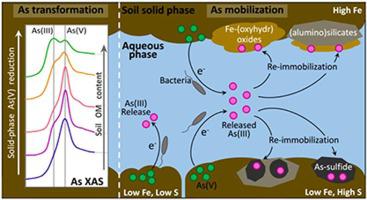Geoderma ( IF 5.6 ) Pub Date : 2022-05-21 , DOI: 10.1016/j.geoderma.2022.115948 Xiaolin Cai , Naiyi Yin , Xiaotong Liu , Pengfei Wang , Huili Du , Yanshan Cui , Zhengyi Hu

|
Microbially-mediated mobilization of soil arsenic (As) is greatly influenced by the soil properties. However, in soils with contrasting iron (Fe), sulfur (S), and organic matter (OM) contents, the biogeochemical pathways controlling As transformation and distribution remain unclear. Using sequential soil As extraction and X-ray absorption spectroscopy (XAS), we investigated the causal mechanisms of As reduction and redistribution in five soils during microbial incubation. Incubation of arsenate (As(V))-reducing bacteria resulted in a significant arsenite (As(III)) release (21.6–61.9% of total soil As (Astotal)). Thereafter, the re-immobilization of released As(III) was controlled by contrasting biogeochemical pathways, which were mainly dominated by soil Fe and S. For soil with high Fe content (191.1 g/kg), As immobilization is attributed to As(III)-readsorption by (neoformed) Fe-(oxyhydr)oxides, despite the presence of abundant S (10.3 g/kg); while in soils with relatively low Fe content (25.9–35.6 g/kg) and high S content (1.4–1.7 g/kg), As-sequestration depends largely on As-sulfide formation (5–47% of solid-phase As), including realgar and orpiment-like phases. In contrast, released As remains in solution in soils with relatively low Fe (27.5–52.4 g/kg) and S contents (0.6–1.0 g/kg). Arsenic-XAS results show that all soil As fractions, including residual As(V), can potentially be reduced (34–92% of Astotal), and solid-phase As(V) reduction was enhanced at higher OM content. Collectively, these results elucidate the dominant biogeochemical pathways controlling As fate in soils with different Fe, S, and OM contents.
中文翻译:

砷在污染土壤中转化和再分布的生物地球化学过程:铁、硫和有机物的综合效应
微生物介导的土壤砷 (As) 迁移受土壤性质的影响很大。然而,在铁 (Fe)、硫 (S) 和有机质 (OM) 含量不同的土壤中,控制 As 转化和分布的生物地球化学途径仍不清楚。使用连续土壤砷提取和 X 射线吸收光谱 (XAS),我们研究了微生物培养过程中五种土壤中砷还原和再分布的因果机制。砷酸盐 (As(V)) 还原细菌的培养导致亚砷酸盐 (As(III)) 大量释放(占土壤总砷的 21.6-61.9%(总))。此后,释放的 As(III) 的再固定化受到对比生物地球化学途径的控制,主要由土壤 Fe 和 S 控制。对于高 Fe 含量(191.1 g/kg)的土壤,As 的固定化归因于 As(III) )-尽管存在丰富的 S (10.3 g/kg),但(新形成的)Fe-(羟基)氧化物的再吸附;而在 Fe 含量相对较低(25.9-35.6 g/kg)和 S 含量较高(1.4-1.7 g/kg)的土壤中,As 的固存主要取决于 As-硫化物的形成(固相 As 的 5-47%) ,包括雄黄和雌黄样阶段。相反,释放的 As 仍保留在 Fe(27.5–52.4 g/kg)和 S 含量(0.6–1.0 g/kg)相对较低的土壤中。Arsenic-XAS 结果表明,包括残留 As(V) 在内的所有土壤 As 组分都有可能减少(总As 的 34-92%),并且在较高的 OM 含量下,固相 As(V) 还原增强。总的来说,这些结果阐明了在不同 Fe、S 和 OM 含量的土壤中控制 As 命运的主要生物地球化学途径。











































 京公网安备 11010802027423号
京公网安备 11010802027423号